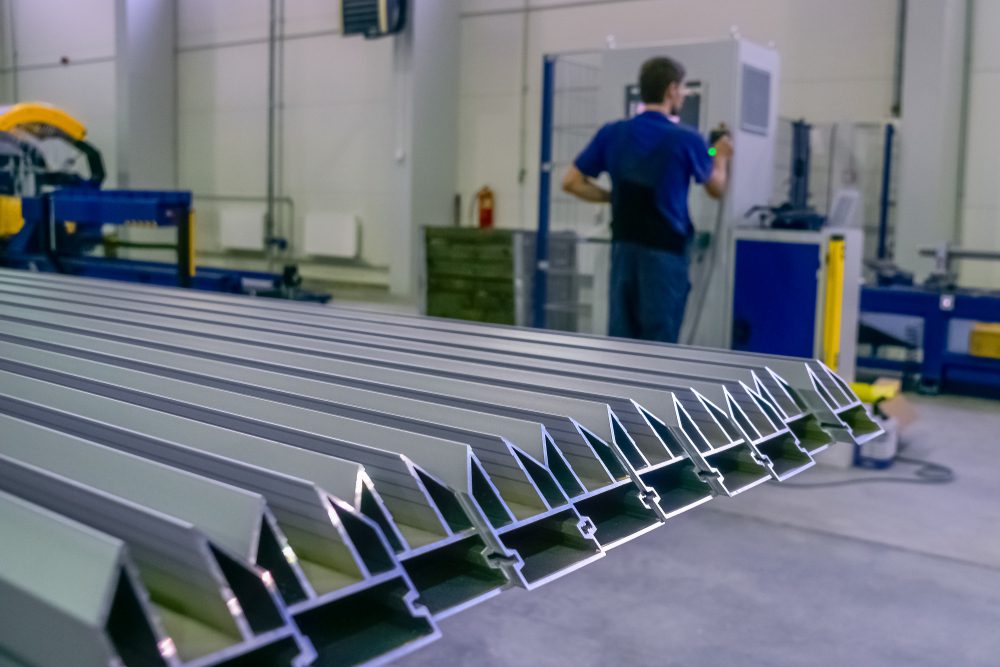Many of us involved in the fenestration sector will have seen from around 20th April, the intention of fabricators, suppliers to fenestration and services to re-open. Businesses are updating their website, their social media statements and also contacting their customers directly.
The opinion of whether this is a good idea continues to provide debate and we repeat our message of understanding and respect for those making the decision to open their premises or remain closed. But we also need to look at those choosing to open their doors objectively.
The purpose of this article is to look at the measures those planning a return to work are taking even if operating at reduced capacity. We also look to see what these businesses are doing by way of new processes to keep safe and keep producing.

Who decided to close first?
At the start of the lockdown businesses in fenestration started following a trend. Most did what they believed to be right in closing their businesses down for the protection of their staff and the public. But it’s also reasonable to consider others weren’t sure what to do. After all, order books were healthy, customers wanted their products. Did they even need to close? With exceptions, most made the decision to close their doors. Others as we know, serving essential sectors remained open.
For some businesses cashflow will have decided the issue. With a serious reduction in sales looming hitting the pause button to evaluate what impact government assistance is going to have, as well as using the time to take stock of all the news and advice coming in.
Looking back at the general message during that time, it was very much closing for the safety of our employees and the public
The reasoning behind reopening
Fast forward to today and the ‘reasoning’ for opening companies now give will invariably be any of these messages
- The government wants us to keep business/construction going
- We need to open to service essential sectors
- There is no restriction on manufacturing under the current rules
- Our customers are asking when will we re-open
- We are putting in new measures and/or here is what we are doing
The Government’s guidance and their clear statement that business should carry on, are repeated and also cited as a reason by many for planning a staged, careful and safe return to operations.
We created our own page on the status of fenestration businesses during the lockdown. This page is now showing more names and more businesses opening their doors.
So what’s changed?
Nothing. Nobody is bending rules neither are they being relaxed. And just like the rules haven’t changed, neither has the virus. What has happened over recent weeks is greater and better absorption of information, guidance and ever-improving advice.
We’ve simply had an evolution of understanding not a change in the rules.
Whether we agree with their purpose or viewpoints, The Glass and Glazing Federation, The Construction Leadership Council and many others have done their best to offer their members guidance and advice. Ultimately it’s professionals and experts most of us choose to rely on.
As a result, these business choosing to open have carefully and responsibly put measures and strategies in place to minimise the risk.
It’s also important to stress once again the diversity of the windows supply chain. Those businesses essential for the construction sector, new build homes and non-NHS work recognise a need for their products and services, even if their personal feeling is to stay home. Their solution is careful thought, planning, facing facts and coming up with safe systems of working.
Seeking advice from Health and Safety professionals and doing even more risk assessment and mitigation than ever before, we now see more and more opening their doors week commencing 20th April, 27th April or early May.
If, as it appears, the way we are living and working right now and the way we will live and work in the weeks and months to come is going to be different, then there is a point of view that businesses, manufacturing, processes and services need to adapt accordingly. Some are doing it now, others are waiting to see. However, it’s here for the foreseeable future and are those remaining closed going to be too late to make the necessary adaptions?
Are we forcing employees back to work against their will?
The question of what happens if an employer says “come to work” and an employee thinks that it’s unsafe to do so raises all sorts of employment law issues. And there’s no sign that Government departments intend to step in, when challenged about this issue ministers have repeated the mantra about PHE’s advice.
Hopefully, a concerned employee would be able to offer constructive points of view that can lead to discussion and implementation of better practice. Whether the lockdown continues as-is or changes, this is likely to be an issue that comes up.
Assessing whether to get back to work.
Even well-known businesses are now looking to get back to work and one of the most recent examples was B&Q.
Fenestration businesses large and small should watch what larger concerns such as B&Q and indeed the bigger organisations in our supply chain are doing. Why? Because the responsibilities they face, the planning, the deployment of new procedures and planning to re-open are arguably far more complex than a small-medium sized firm. Not to mention the bigger headache to deal with should it all go wrong. They are better placed than most to get the best advice and do things the right way.
Are new systems, processes and procedures realistic?
As we see it, B&Q like fenestration businesses choosing to open, assessed, considered, ran a trial, studied the guidelines and developed a system. The conclusion reached was they could responsibly open their business.

What is being done?
The ability of a fenestration-related business to open depends on a number of factors. The size of the factory, the proximity of benches, machinery, goods in/goods out and all manner of considerations.
For window and door manufacturing, there are ways one fabricator can make smaller products such as reasonably sized windows and single doors. Anyone who’s ever made, for instance, a single commercial door leaf will accept it can be put together by one person. Curtain walling, large sliding doors, bifolding doors and screens need a different approach to fabrication as does glass, extrusions and larger items.
People will rightly ask, how can you put these larger (2-man) products together while maintaining social distancing? One of the answers could be, the responsible fabricator has looked at the process and changed it. Every fabricator is different as we cannot assume they all work in the same way. Speak to systems companies setting up fabricators of their system and they’ll tell you no one factory is the same.
It is also true that owners of smaller factories will carry out their own assessments and conclude they cannot observe guidelines and social distancing. It is therefore best they stay closed.
Others have the benefit of space, changing the layout of the production spays and also seeing the advice of professionals. Above all, it is responsible, measured and careful consideration that allows a business to re-open in a safe and responsible way that’s most important.
In a factory environment these are just some changes businesses are making
People
- Investment in infrared equipment for taking staff temperates every day
- On arrival, self-certification related to symptoms and strict record keeping
- Changes to breaks, how they’re taken, when and by how many.
- New/ongoing training so members of staff understand at all times processes in place
- Enhanced supervision and ongoing shop floor checks ensuring staff remain compliant
- Photographic evidence and record-keeping of usage of PPE, of workstations and working practices
- Not shaking hands and more frequent hand washing
Equipment
- The purchasing of PPE equipment for employees
- The placement of new information signs throughout the premises
- Additional hand sanitisers at frequently visited areas, canteens, washrooms, receptions, clocking-in areas etc
- Each work-station with its own cleaning/sanitising including desks, keyboards and computer equipment
- Frequent cleaning of high-traffic objects such as doors to WC, canteen, kettles, etc
Processes
- The creation of new Risk Assessments and the adoption of safe working practices and policies
- Increased and routine cleaning, disinfection or professional cleaning of high traffic areas and frequently contacted surfaces
- Clearly marked distance points or lines throughout the production area
- Changes to hours of work, shift patterns.
- Batch cutting, machining or assembly to reduce the number of people involved with each separate process.
- Communication with/between factory staff using technology instead of face to face
- Keeping to the 2m safe distance
Procurement and Delivery
- Pre-despatch checks with the customer ensuring the delivery location also have suitable risk mitigation measures in place.
- Ensuring recipients are not displaying any symptoms
- Asking to see evidence of their procedures before making deliveries
- Investment in equipment to handle off-loading in place of staff
- PPE and cleansing equipment fitted out in delivery vehicles
- Enhanced cleaning of shared delivery vehicles
The implementation of all these new processes and procedures is challenging and daunting for many business owners. There is nothing to compare with this present scenario facing owners of any manufacturing and supply chain business. However, they’ll also be aware of how they’ve constantly needed to adapt to changes in regulation, health and safety and procedures generally throughout their business live.
Importantly, nobody has a patent or trademark on the above mentioned measures. They’re there for us all to consider using or even improving.
What about showrooms?
The retail slide of our industry faces bigger challenges given the public facing side of it and restrictions for working in people’s homes.
We are starting to hear from those with showrooms considering how they may plan a return to work. Once again there is no one size fits all. Showrooms by companies such as Express Bifolding Doors bear little relation to a small shop on the high street.
The intention of many installations businesses is to work on new-builds and unoccupied properties. There is no intention to carry out replacement window and door work right now. A reminder that not every installer is the same and some do very little replacement window work in the first place.
Conclusion
Communication is crucial. There is a strong argument for the manufacturing and logistics chains to come together and share information for the benefit of the entire sector. And we urge companies to consider this seriously.
Right now, it’s the sharing of information that will help many get back to work. We’ve seen incredible examples of businesses sharing and making available their operating procedures, risk assessments, guidance from industry bodies and even templates for those with a 3D printer to print visors. This sharing of information must also extend further, be it to colleagues and friends, suppliers, sub-contractors, and even industry experts and professionals.
Businesses planning to re-open need to consider government guidance, consider the opinion of experts and seek the advice of professionals they trust.
If ever there was a time to be sceptical of loud social media voices or double glazing opinion websites it is now. Unfounded predictions of doom and gloom or overuse of emotive sentiment and images add nothing to the debate and should be read with an inquisitive mind.











